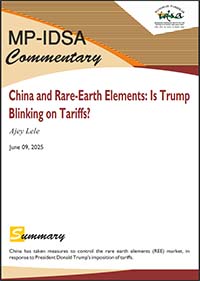China and Rare-Earth Elements: Is Trump Blinking on Tariffs?
- June 09, 2025 |
- IDSA Comments
In response, on 4 April 2025, China placed export restrictions on REEs, which are also known as rare metals. China’s retaliatory tariffs led to escalating tensions between the two states. There was a war of words between President Xi Jinping and Trump, which led to the US imposing a 145 per cent levy on Chinese imports, on 9 April. In return, Beijing introduced a 125 per cent duty on some US goods.
Within a month, though, some good sense prevailed and both countries agreed to de-escalate the trade tensions. In May 2025, officials from the US and China met in Geneva for talks. On 12 May, they reached an agreement to reduce tariffs. They agreed to cancel some tariffs altogether and suspend others for 90 days.[i] However, regarding REEs, China has not adopted a lenient approach towards export restrictions. Currently, this has caused significant disruption across various manufacturing sectors, including defence.
Presently, China produces around 90 per cent of the world’s REEs. Rare earth elements are a group of 17 metallic elements which are critical in the functioning of various industries, mainly defence, energy and electronics industries. They play a critical role in the manufacturing of electric vehicles (EVs). In April 2025, China implemented export controls on seven categories of medium and heavy rare earths, which include samarium, gadolinium, terbium, dysprosium, lutetium, scandium and yttrium. These controls cover not only raw minerals, but also finished products such as permanent magnets, which are difficult to replace due to their specialised manufacturing processes.[ii] It appears that China has banned those specific elements, which are vital for the US economy.
Major industrial houses in the US like Lockheed Martin, Tesla and Apple have Chinese rare earths in their supply chains. For the US aerospace sector, there is a significant dependence on China for REE supply. For instance, each Lockheed Martin F-35 fighter jet integrates about 920 pounds of rare earths, and an Aegis destroyer needs around 5,200 pounds. These minerals are essential in the production of radar, sonar and missile guidance systems.[iii]
Within two months after China started controlling the REE exports, the global industry began to feel significant pressure. Key sectors like automotive manufacturing and aerospace are not able to continue with their production cycles. This disruption is not limited to the US alone, German carmakers and Indian auto industry are also facing problems. The US semiconductor industry has suffered since December 2024 because by then China had put restrictions on the export of gallium and germanium, specifically to the US. These restrictions were put in response to the US export controls on advanced chipmaking technology. China currently controls 94 per cent of the global supply of gallium and 83 per cent of germanium.[iv] It has also been reported that in Japan, Suzuki has halted production of the Swift car from 26 May alluding to a shortage of components.
All this forced the US President to have a friendly call with Chinese leader Xi Jinping on 5 June. This was the first telephonic conversation between these two leaders after Trump took over the presidency around six months ago. After the talks, President Trump has stated that the complexity of Rare Earth products no longer exists. However, the Chinese side appears to be giving no guaranties. In fact, China is continuing to expand and enhance its export controls over rare earths and other critical minerals by rolling out new licensing constraints and cracking down on smuggling.[v] China is known to have stopped Chinese companies from having any dealings with various US companies mainly dealing with the production of military equipment.
REEs also go into the chemicals used in the production of jet engines, lasers, car headlights and certain spark plugs. For electronic components, particularly in making computer chips, REEs are important. In the present-day world, such chips are known to also power artificial intelligence servers and smartphones. Likewise, heavy rare earth metals are used in magnets vital for various types of electric motors. Various magnets are produced by using heavy rare earths. These metals help in preventing magnets from losing their magnetism. They are required in the automobile industry and industries dealing with the production of robots, drones and spacecraft. Presently, shipments of these magnets have been halted at many Chinese ports.[vi] This indicates that China is fittingly responding to the new tariff policies articulated by the US.
Conclusion
It is important to note that REEs are not as rare as their name suggests. Today, China has emerged as a dominant force in the REE industry, primarily due to its strategic vision and bold and timely investments. China accounts for approximately 70 per cent of the world’s rare earth mining and over 90 per cent of its processing. Over the years, they have mastered the complex processes of mineral excavation and refining. This has helped them to dominate the global REE market for many decades.
While some countries possess REE deposits, they have not ventured into REE mining due to technical, commercial and geopolitical challenges. The strategic importance of REEs for various industries is well recognised, and China is effectively leveraging its dominance in this field. In response to the US President Trump’s imposition of additional tariffs, China has taken measures to control the REE market. Within two months of the tariff announcement, China has succeeded in disrupting global REE supply chains. Currently, countries like Brazil, Myanmar and Laos are involved, directly or indirectly, in the mining, processing and/or production of REEs. China maintains significant involvement in the supply chains from these nations as well.
President Trump appears to have recognised the costs of escalating trade tensions with China, especially after the disruption of the REE supply. The US administration is now attempting to re-engage with China diplomatically. However, China is unlikely to concede easily and may seek substantial concessions before agreeing to any compromises. Meanwhile, the US tariff policies have not only hurt domestic industries but have also adversely affected various industrial sectors globally. This underlines the necessity for nations to reduce their (over)dependence on China and expedite efforts to identify alternative sources and strategies to mitigate such challenges.
Views expressed are of the author and do not necessarily reflect the views of the Manohar Parrikar IDSA or of the Government of India.
[i] Jennifer Clarke, “What Tariffs has Trump Announced and Why?”, BBC, 4 June 2025.
[ii] “China Hits Back at US Tariffs with Export Controls on Key Rare Earths”, Reuters, 5 April 2025.
[iii] “America Dropped the Baton in the Rare-Earth Race”, Foreign Policy, 23 June 2023.
[iv] “GLOBSEC on China export ban”, GLOBESEC, 8 December 2024.
[v] “Even after Trump-Xi Call, China’s Rare-earth Controls Aren’t Going Away”, The Washington Post, 6 June 2025.
[vi] Keith Bradsher, “China Halts Critical Exports as Trade War Intensifies”, The New York Times, 13 April 2025.






